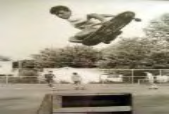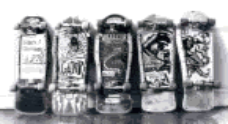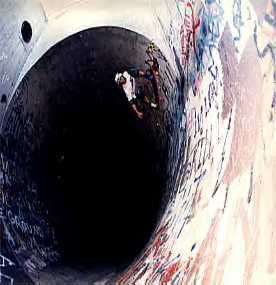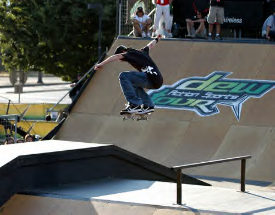
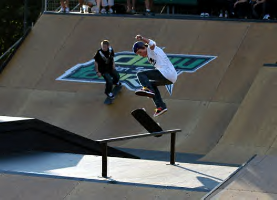
SKATEBOARDING
PART OF AMERICAN
SPORTS
PART OF AMERICAN
SPORTS
Skateboarding has been part of the scene since the 1950's.
The first unofficial skateboards were actually scooters.
When the handles were broken off and all that was left was
the roller skate wheels on a two by four the first skateboards
were born. Skateboarding was considered "land surfing"
at the height of the surfboard craze in the '50's. The con-
nection to surfing gave skateboarding a direction that in-
fluenced maneuvers and style to fashion and attitude.
It was in this time period that changes were made to the
trucks to make it easier to maneuver and by 1959 the first
Roller Derby Skateboard was for sale. The first mass-
produced skateboards were made in the early '60's by
companies such as, Hobie Alter's (The Hobie) and Larry
Stevensons (Makaha) which were the first surfing-inspired
skateboards. Skateboarding was an overnight success
and over 50 million skateboards were sold in a 3 yr. period.
The very first skateboarding contest was held in Hermosa
Beach, California in 1963. But in 1965, a safety committee
warned about possible "unsafe" conditions and skate-
boarding entered its first slump. It was during this time
that Larry Stevenson's company invented the Kicktail.
This set a new skateboarding standard for doing tricks.
In 1973 the sport was revolutionized again by the inven-
tion of the urethane wheel. The 1980's was another growth
phase for the sport. Street style skateboarding and the
plywood ramp turned backyards and parks into free-
skate parks. Innovations in board and truck size allowed
the trick envelope to be pushed further than ever before.
Influencing the sport were former pros who started com-
panies such as World Industries by Steve Rocco.
The "Ollie" came into its own in this decade making it the
foundation for 80% of street tricks and approximately
60% of vert tricks, focusing on more technical and larger
tricks. In 1995, ESPN held its first Extreme Games in
Rhode Island. This "rebel sport" was suddenly closer to
the mainstream. Skateboarding was included in a Cross-
over event in the 1997 Winter X Games, along with in-line
skating, bicycle stunts and snowboarding. Advertisers
that previously ignored skateboarding suddenly had the
"stars" in campaigns from everything from soda to potato
chips to phone companies. Vert skateboarding made a
comeback in the '90's due to the large number of skateparks
built. The different ramps, pipes and bowls led to a change
in equipment. There were now a large range of boards and
wheels available. Downhill skateboarding has also been
popularized due in part to the visibility of the street luge.
The first unofficial skateboards were actually scooters.
When the handles were broken off and all that was left was
the roller skate wheels on a two by four the first skateboards
were born. Skateboarding was considered "land surfing"
at the height of the surfboard craze in the '50's. The con-
nection to surfing gave skateboarding a direction that in-
fluenced maneuvers and style to fashion and attitude.
It was in this time period that changes were made to the
trucks to make it easier to maneuver and by 1959 the first
Roller Derby Skateboard was for sale. The first mass-
produced skateboards were made in the early '60's by
companies such as, Hobie Alter's (The Hobie) and Larry
Stevensons (Makaha) which were the first surfing-inspired
skateboards. Skateboarding was an overnight success
and over 50 million skateboards were sold in a 3 yr. period.
The very first skateboarding contest was held in Hermosa
Beach, California in 1963. But in 1965, a safety committee
warned about possible "unsafe" conditions and skate-
boarding entered its first slump. It was during this time
that Larry Stevenson's company invented the Kicktail.
This set a new skateboarding standard for doing tricks.
In 1973 the sport was revolutionized again by the inven-
tion of the urethane wheel. The 1980's was another growth
phase for the sport. Street style skateboarding and the
plywood ramp turned backyards and parks into free-
skate parks. Innovations in board and truck size allowed
the trick envelope to be pushed further than ever before.
Influencing the sport were former pros who started com-
panies such as World Industries by Steve Rocco.
The "Ollie" came into its own in this decade making it the
foundation for 80% of street tricks and approximately
60% of vert tricks, focusing on more technical and larger
tricks. In 1995, ESPN held its first Extreme Games in
Rhode Island. This "rebel sport" was suddenly closer to
the mainstream. Skateboarding was included in a Cross-
over event in the 1997 Winter X Games, along with in-line
skating, bicycle stunts and snowboarding. Advertisers
that previously ignored skateboarding suddenly had the
"stars" in campaigns from everything from soda to potato
chips to phone companies. Vert skateboarding made a
comeback in the '90's due to the large number of skateparks
built. The different ramps, pipes and bowls led to a change
in equipment. There were now a large range of boards and
wheels available. Downhill skateboarding has also been
popularized due in part to the visibility of the street luge.
The two main skateboarding
organizations are the IASC(Inter-
national Assoc. Of Skateboarding)
and World Cup Skateboarding
which is the leading Competition
Organization. Today a pro can
range from $1,000 to $10.000 a
month , says Danielle Bostick of
World Cup Skateboarding and
the X Games. These earnings are
reflected in how well a skateboarder
places in competitions and how
many competitions they enter in
a month. They can also earn a
monthly salary when they are
sponsored by a company as a
team rider. Skateboarding has
been enjoyed by kids as young
as two years old ( with parental
supervision) . The majority of
pros, however, range from early
teens to early twenties. Many
skateboarders also surf and
snowboard which is extreme sports
cross training. But mainly skate-
boarders skate just for fun and
the love of the sport!
organizations are the IASC(Inter-
national Assoc. Of Skateboarding)
and World Cup Skateboarding
which is the leading Competition
Organization. Today a pro can
range from $1,000 to $10.000 a
month , says Danielle Bostick of
World Cup Skateboarding and
the X Games. These earnings are
reflected in how well a skateboarder
places in competitions and how
many competitions they enter in
a month. They can also earn a
monthly salary when they are
sponsored by a company as a
team rider. Skateboarding has
been enjoyed by kids as young
as two years old ( with parental
supervision) . The majority of
pros, however, range from early
teens to early twenties. Many
skateboarders also surf and
snowboard which is extreme sports
cross training. But mainly skate-
boarders skate just for fun and
the love of the sport!
